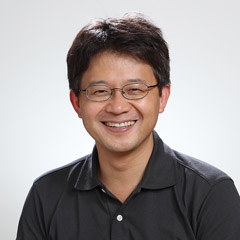Katsushika Hokusai, Nami-ura
Many Japanese feel astounded when they know that Hokusai is considered as the most famous Japanese artist in the Western countries. The art-historical assessment in Japan also turns out differently than one would probably expect from a Western perspective. For example, it was only in 1997 that one of his works was admitted as Japan’s cultural heritage for the first time by the Japanese Ministry of Culture.
In order to understand this understatement, one needs to understand the socio-historical context of the time of the period when Hokusai produced this work: In the Hokusai's lifetime, an ukiyo-e master was considered as a mere craftsman. This, for example, represents a strong contrast to the Kano school artists, whose focus was primarily on Chinese painting. Many of the Kano school artists worked as the shogunate’s official painters, which enabled them to be part of the warrior class. In feudal society there was an unbridgeable clear class difference between those artists and ukiyo-e masters. Moreover, ukiyo-e was considered vulgar, as it was a medium for common people and some were even pornographic. Today “ukiyo-e” specially represents Japanese woodblock prints of the later Edo period. But actually the term ukiyo originally has a Buddhism-originated, rather pessimistic meaning, namely: “transitory world”, which contrasts to the word jōdo as “pure land” or “paradise”. “Ukiyo-e” in this context would mean “images from this world”. However, it was precisely in the Edo period mentioned about the attempt of reinterpretation, especially among townspeople, to perceive, affirm and even enjoy this temporary, worldly world as something positive. Accordingly, despite its originally negative meaning of the word, motifs that came to mean everyday, life-affirming, bourgeois life were often chosen for “ukiyo-e”.
In the Hokusai's lifetime his artistry1 in this sense certainly met with positive response and interest from the townspeople in Edo (today Tokyo). But it was French art critics and modern artists at the end of the 19th century who gave Hokusai “world-class” status. With the style of the so-called Japonisme they hoped to get impulses or artistic suggestions from the color woodcuts or lacquer works to overcome the hopelessly frozen academic European art from their viewpoint; bold, asymmetrical compositions, spontaneous drawing, strong colors, overcoming the central perspective. It seems clear that the view of these Europeans on Japanese works of art was from the beginning selective. And obviously Hokusai was an ideal projection here.
In Hokusai's extensive oeuvre the “Thirty-six Views of Mount Fuji” is regarded as his main work. Among all of Hokusai’s works, “The Great Wave off Kanagawa” particularly has attached special attention in the West until the present day. Already in 1897 Camille Claudel (1864-1943) created her work “La Vague”, which was inspired by “The Great Wave” and in 1888 Vincent van Gogh (1853-1890) pointed out the special nature of this work in a letter to his brother. Eventually “The Great Wave” established itself as an “global icon” as one acknowledged today.2 According to the English art historian Christine M. E. Guth, it was decisive for the enormous spread of the picture that in the West, “The Great Wave” was chosen as the title to differ from the original “The Backside of the Wave”. In this way, the image has been separated from the original context.3
The fascination, which this work still holds globally today, certainly lies all in the geometrical or typically Japanese asymmetrical composition and the dynamic representation of the big waves. Thereby the horizon is set unusually low, which additionally serves to increase the effects. The position is actually very unnatural and almost impossible. Here it is important to point out that this perspective representation was a result of Hokusai's attempt to appropriate or interpret the European central perspective. It was in the early 18th century that the Japanese began to deal intensively with this Western style of painting. By directly connecting the foreground and the distant view without a middle ground, they found a particularly effective means of dramatic representation, which in reality deviated from the actual Western painting principles. The Japanese art historian Shigemi Inaga calls this typical Japanese expression “chūkei-datsuraku (falling out of the middle ground)”.4 Many ukiyo-e masters liked to make use of this manner. Also in Hokusai's “The Great Wave” it seems to have succeeded impressively. As already expressed in the original title “Nami-ura” (the backside of the wave), the picture draws the viewer's gaze deep into the inner side of the devouring movement of the waves. Thereby a literally sublime feeling is awakened in the observer. In front of this mighty natural phenomenon, the people in the picture look powerless, as if they were merely driven by the waves. The holy Mount Fuji silently watches all this sight from far away.
Mount Fuji, a 3776 meter high volcano, is not only the highest mountain in the country, but has been worshipped as a religious object in ancient Japan. On the one hand, Fuji with its rich water reservoir provided fertility, but on the other hand its eruptions caused great damages to the population. Accordingly, it was always regarded with a certain reverence and in the 9th century the first shrine for the fire god “Asama” was built on it. The mountain then also became a holy place for Buddhists. The Mount Fuji worship became especially popular during the Edo period. The most eloquent example is Hokusai’s “Thirty-six Views of Mount Fuji”. Otherwise Mount Fuji was chosen as subject of the painting again and again since the 11th century at the earliest. Later, at the peak of nationalism in Japan, especially during the second Sino-Japanese War and the Pacific War (1937-1945), the mountain was identified with the nation “Japan” per se and eventually became an authentic “national symbol”. After World War II it was then seen as a symbol of the new, revived Japan. Based on these historical backgrounds it seems obvious that many Japanese perceive something particularly familiar in the depiction of Fuji in the work “Nami-Ura”. In this sense, it is quite significant that Mount Fuji was recognized by UNESCO as a World Cultural Heritage in 2013, as a “sacred place and source of artistic inspiration”.
Today, the image “The Great Wave” is often used for merchandising products of museums, such as coffee mugs, plates, notebooks, ties, T-shirts, wristwatches or umbrellas, and is extremely successful. The Japanese government finally jumped on this trend at the beginning of the 21st century when it developed a state-sponsored marketing strategy based on “Cool Japan”, a neologism created by the American journalist Douglas McGray, in which the Japanese subculture such as manga or anime would play a major role. The motif was also used for the “Cool Japan” project. Guth sees this as the final recognition of Hokusai on the Japanese side.5
Inaga writes that Hokusai was an artist who had gained his unique historical significance in the international context of Japonisme "as a sociological phenomenon“.6 The shift in Hokusai's evaluation for over a century makes his creative approach a complex construct of the artistic, cultural and social development of the Edo period. Inaga notes that “many things that today are considered the essence of Japanese aesthetics were actually refined in dealing with imported culture. […] Cultural characteristics are not revealed in isolation, which shields itself from foreign influences, but rather through curiosity about the outside world“7. Especially Hokusai's art is a prime example of this statement.
Download a more detailed version of this essay by Nobumasa Kiyonaga (in German).
Footnotes
1 The concept of art with the European sense did not exist in Japan at that time yet. For this reason the author avoids the term “art“ at this point. It was only after the opening of Japan to the Western countries in the 1850s that the term was newly introduced from Europe as a translation word.
2 Christine M. E. Guth (2017): 21 Seiki no Yōroppa · Amerika bunka no naka no “Ōnami” (eng: The Great Wave in Twenty-first Century Euro-American Culture), in: exh.cat. Hokusai and Japonisme, Tōkyō: Kokuritsu seiyō bijutsukan (The National Museum of Western Art) und Yomiuri shinbun Tōkyō honsha, p. 296.
3 Guth (2017): Ibid.
4 Shigemi Inaga (1999): Kaiga no tōhō – Orientarizumu kara Japonisumu e (eng: The Orient of the Painting: Orientalism to Japonisme, Nagoya: The University of Nagoya Press, p. 90ff.
5 Guth (2017): pp. 298-299.
6 Inaga (1999): p. 174.
7 Shigemi Inaga (2018): Nihon-bijutsu-shi no kindai to sono gaibu (eng: The modernity of Japanese art and its outside) Tōkyō: Hōsōdaigaku kyōiku shikōkai, p. 33.
published June 2020


